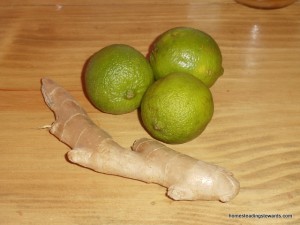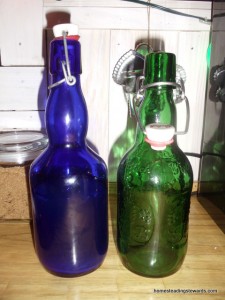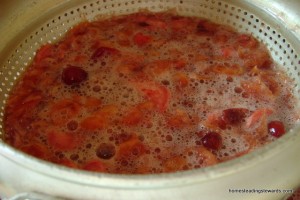 This gingerale recipe has been tried and tweaked by Roy for quite a few winters. It can be made mild or stout and the carbonation comes from the yeast reacting with the sugar. There have been variations on the theme, including adding cranberries this year, and while a few do not care for it at all, most of us fight over who gets the last bottle. It has sort of become a family tradition each winter and our oldest girl made this the subject of her science project one year. It takes a few steps and patience waiting for it to get to the final stage of carbonation, but if you are one of the ones who loves it, it is worth the trouble and time. It isn’t terribly time consuming to make , it’s mostly time waiting on it.
This gingerale recipe has been tried and tweaked by Roy for quite a few winters. It can be made mild or stout and the carbonation comes from the yeast reacting with the sugar. There have been variations on the theme, including adding cranberries this year, and while a few do not care for it at all, most of us fight over who gets the last bottle. It has sort of become a family tradition each winter and our oldest girl made this the subject of her science project one year. It takes a few steps and patience waiting for it to get to the final stage of carbonation, but if you are one of the ones who loves it, it is worth the trouble and time. It isn’t terribly time consuming to make , it’s mostly time waiting on it.
Gingerale
2 qts. water
1/2 cup sliced ginger root
juice of 3 limes (and/or 1 bag of cranberries)
2 cups sugar
1 tsp active dry yeast
Put first 3 ingredients in a pot. Bring to a boil and let boil 5-10 minutes. The longer it boils, the stronger the flavor (I vote for longer!).
Pull off heat and add the 2 cups of sugar. Stir until dissolved. For a “heartier” taste, substitute 1 cup of dark molasses for 1 cup of sugar.
Strain through a sieve to get out the large pieces of ginger. Fill a clean gallon jug (we use a washed out milk jug) with the mixture and add 2 qts cold water to fill (leave a few inches of head room) and 1 tsp of active dry yeast.
Put lid on, swirl a few times to incorporate yeast, then LOOSEN THE CAP! Put in a warm spot (we use the top of the fridge) and allow to sit 4-6 hours (on a towel). The sediment will settle to the bottom.  When the 4-6 hours are up, use a funnel to pour into glass bottles that can be stoppered (we use bottles with swing-top stoppers that can be ordered online). Be sure to leave some head room in the bottles and then cap them. Put the bottles back in the warm spot and let sit for 6 hours or overnight and then immediately refrigerate. DO NOT leave for longer because the bottles WILL explode due to the carbonation that is taking place inside. (For this reason, you may prefer a spot outside if it is warm). We have never had this happen, but we were pushing it once when we forgot and left them longer than intended…so, don’t talk yourself out of trying this, just make a note and remember. The refrigerator stops the fermenting process, and as soon as it’s cold, it is ready to enjoy, but open the bottle over the sink in case it foams out (like a coke that’s been shaken). It doesn’t usually, but does occasionally.
When the 4-6 hours are up, use a funnel to pour into glass bottles that can be stoppered (we use bottles with swing-top stoppers that can be ordered online). Be sure to leave some head room in the bottles and then cap them. Put the bottles back in the warm spot and let sit for 6 hours or overnight and then immediately refrigerate. DO NOT leave for longer because the bottles WILL explode due to the carbonation that is taking place inside. (For this reason, you may prefer a spot outside if it is warm). We have never had this happen, but we were pushing it once when we forgot and left them longer than intended…so, don’t talk yourself out of trying this, just make a note and remember. The refrigerator stops the fermenting process, and as soon as it’s cold, it is ready to enjoy, but open the bottle over the sink in case it foams out (like a coke that’s been shaken). It doesn’t usually, but does occasionally.
With Cranberries:
If you want to try it with cranberries, you can use or omit the lime juice. This was the first year we tried it and I think it has been our favorite so far. There are a few things we will try next time to adjust it, but here’s what we learned. The cranberries have sugar of their own, so the amount of sugar may need to be cut back. We didn’t this time and it had carbonated so much that the whole bottle would spew out when opened. We ended up with a few inches of liquid in each bottle. A disappointment because it was so good.
To process the cranberries, we cooked them with the ginger root and water and then drained it into a cone sieve (an old fashioned ricer) on a stand and mashed the liquid out with the pestle into a bowl beneath. (Roy then made FABULOUS ginger candy with the cranberry infused ginger pieces). Then followed the same process used with the regular gingerale.

If you try this for yourself, we’d love for you to let us know how it turned out and if you did anything different that worked or didn’t.